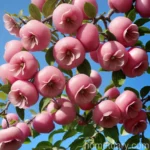Sargent Crabapple (Malus sargentii ‘Candymint’)
Introduction
Sargent crabapple, scientifically known as Malus sargentii ‘Candymint’, is a delightful ornamental plant that belongs to the genus Malus in the Rosaceae family. This species is highly valued in landscaping for its beautiful spring blooms, attractive foliage, and ornamental fruit. In this blog post, we will explore the various aspects of Sargent crabapple, including its cultural requirements, uses, maintenance, and more.
What is a Sargent Crabapple?
Sargent crabapple is a small deciduous tree that typically grows to a height of 6-10 feet with a spread of 12-20 feet. It is native to Japan and was introduced to the United States by Charles Sprague Sargent, after whom it is named. This tree is valued for its ornamental features, including its profuse pink or white blossoms in spring, colorful foliage in the fall, and small red fruits that persist into winter, providing food for wildlife.
Key Takeaways
Before exploring the specifics of growing and caring for Sargent crabapple, let’s take a look at some key takeaways:
- Plant Name: Malus sargentii ‘Candymint’
- Type: Deciduous tree
- Height: 6-10 feet
- Spread: 12-20 feet
- USDA Hardiness Zones: 4-8
- Bloom Time: Spring
- Fruit Color: Red
- Growth Rate: Moderate
- Water: Regular watering
- Sunlight: Full sun to partial shade
Now, let’s delve into the various aspects of Sargent crabapple cultivation and care.
Culture
Uses
Sargent crabapple has several uses, primarily in landscaping and ornamental horticulture. Some common uses include:
- Ornamental Tree: The tree is primarily grown for its aesthetic appeal, including its beautiful blossoms, foliage, and fruit.
- Wildlife Habitat: The fruit of the crabapple tree provides a valuable food source for birds and wildlife, making it a popular choice for wildlife-friendly gardens.
- Pollinator Support: The flowers of the Sargent crabapple attract pollinators such as bees, butterflies, and other beneficial insects, making it a valuable addition to pollinator gardens.
Growing Conditions
Water
- Water Requirements: Sargent crabapple trees prefer well-drained soil and regular watering, especially during dry periods. Adequate moisture is essential for the tree’s growth and fruit development.
Sunlight
- Sun Exposure: Plant the Sargent crabapple tree in a location that receives full sun to partial shade. Full sun is preferable for optimal bloom and fruit production.
Fertilizer
- Fertilization: Apply a balanced, slow-release fertilizer formulated for trees in early spring, before new growth begins. Follow the manufacturer’s recommendations for application rates and methods.
Soil
- Soil Type: Sargent crabapples prefer well-drained, slightly acidic soil. Amending the soil with organic matter can improve its texture and fertility, promoting healthy tree growth.
Pruning
Pruning Techniques
Pruning is an essential aspect of Sargent crabapple tree maintenance. Here are some pruning techniques to consider:
- Regular Pruning: Perform annual pruning to remove dead or diseased branches, improve the tree’s structure, and promote air circulation within the canopy.
- Thinning: Thin out crowded branches to reduce the risk of disease and allow sunlight to penetrate the canopy, promoting better fruit production and overall health.
Pruning Schedule
- Optimal Time: Prune the tree during the dormant season in late winter or early spring, before new growth begins. Avoid pruning during the active growing season to minimize stress on the tree.
Propagation
Propagation Methods
Sargent crabapples can be propagated through several methods, including:
- Seed Propagation: While possible, growing crabapples from seed may result in variability in tree characteristics. It is often used for breeding new varieties rather than reproducing existing ones.
- Grafting: Propagate Sargent crabapples through grafting onto suitable rootstock. This method ensures that the new tree inherits the desirable characteristics of the parent plant.
Container Gardening
Popularity in Containers
While Sargent crabapples are typically grown in the ground, they can also thrive in containers under the right conditions. Here are some considerations for growing them in containers:
- Container Size: Choose a large, sturdy container with adequate drainage holes to accommodate the tree’s root system as it grows.
- Soil: Use well-draining, high-quality potting mix formulated for trees and shrubs to provide the necessary nutrients and aeration.
Common Diseases
Disease Diagnosis
Sargent crabapples, like many ornamental trees, are susceptible to certain diseases. Common diseases that may affect them include:
- Apple Scab: This fungal disease appears as dark, scabby lesions on the leaves and fruit, leading to defoliation and reduced vigor. Proper cultural practices and fungicidal treatments can help manage apple scab.
Disease Prevention
Preventive measures can help minimize the risk of disease in Sargent crabapples:
- Good Air Circulation: Ensure proper spacing and pruning to promote air movement within the canopy, reducing the risk of fungal diseases.
- Sanitation: Remove and dispose of fallen leaves and fruit to reduce the likelihood of disease spores overwintering and spreading to the next growing season.
Common Pests
Pest Control
Several pests can pose a threat to Sargent crabapples. Common pests may include:
- Aphids: These small, soft-bodied insects feed on the sap of the tree, potentially causing distortion or discoloration of foliage. Insecticidal soaps or horticultural oils can help manage aphid infestations.
Botanist’s Tips
- When selecting a location for planting Sargent crabapple trees, consider their mature size and branch structure to ensure they have adequate space to grow and develop.
- Regular observation is important, as it allows for the early detection of pests, diseases, or any cultural issues that may arise. Timely intervention can help prevent problems from escalating.
Fun Facts
- The Sargent crabapple is named after Charles Sprague Sargent, an influential botanist and the first director of the Arnold Arboretum in Boston, Massachusetts.
- The brightly colored fruits of the Sargent crabapple persist throughout the winter, adding visual interest to the landscape and providing a food source for birds.
Links to External Resources
For further information on Sargent crabapple (Malus sargentii ‘Candymint’) and related topics, consider exploring the following resources:
In conclusion, Sargent crabapple (Malus sargentii ‘Candymint’) is a charming and versatile tree with ornamental and ecological value. By meeting its cultural requirements and implementing proper care practices, enthusiasts can enjoy the beauty of its blossoms, foliage, and fruit while contributing to the local ecosystem. Whether planted in landscapes or containers, the Sargent crabapple is sure to add color and interest to any outdoor space.















